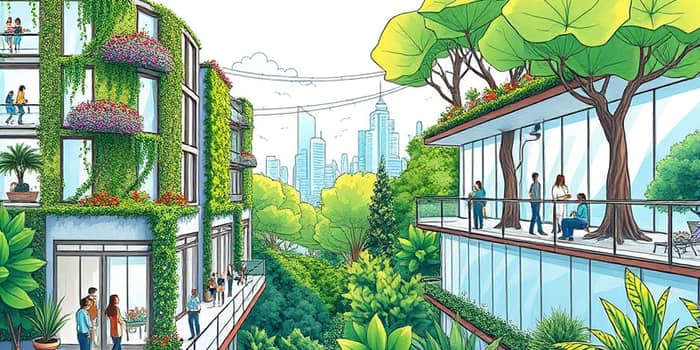
In a world hungry for growth yet wary of risk, we discover a profound path to prosperity and purpose. Biophilic design goes beyond green facades and decorative plants. It is a dynamic framework that aligns human ingenuity with regenerative power of nature. By weaving natural elements into our living and working spaces, we unlock hidden streams of value that nourish both balance sheets and human souls.
Embracing the restorative power of natural environments transforms ordinary spaces into thriving ecosystems of creativity, health, and connection. This approach fosters resilience, inspiring organizations and communities to flourish even amid economic uncertainty.
Biophilia, the innate human drive to connect with living systems, underpins this design philosophy. Architects, planners, and investors leverage this impulse by incorporating organic forms, living materials, and sensory experiences drawn from nature.
The guiding pillars of biophilic design revolve around three core concepts: direct engagement with natural elements, symbolic representation of ecosystem processes, and spatial arrangements that mimic outdoor environments. Together, these strategies enhance well-being and spark innovation.
This philosophy rests on six foundational principles: environmental features, natural shapes and forms, natural patterns and processes, light and space, place-based relationships, and evolved human-nature connections. Applying these ideas ignites a powerful synergy between people, place, and planet.
Concrete data confirm that environments rich in biophilic elements drive measurable financial returns. Daylight and plant views in offices boost revenue by improving team performance and cutting turnover. In one study, employees reported a 25 percent increase in well-being when surrounded by greenery and natural light, directly correlating with profit gains.
Healthcare facilities featuring indoor gardens and natural vistas see shorter patient stays and reduced reliance on pain medication. Cities with expanded vegetation cover report lower chronic disease rates, delivering multimillion-dollar savings in public health expenditures.
Urban canopy expansion also delivers dramatic social dividends. Increasing tree coverage by ten percent can lower crime by thirteen percent, translating into tens of millions in saved security and correctional costs. Real estate values rise in tandem, lifting property tax revenues and spurring broader economic vitality.
Successful biophilic projects weave nature into every design decision. At the enterprise level, decision-makers prioritize site analysis, local ecology, and cultural narratives to create authentic, resilient environments that strengthen community ties and brand reputation.
Investors should view biophilic features as capital assets. While upfront costs may be higher, the long-term financial and social benefits often recoup twice the initial investment within five to seven years, driven by energy savings and heightened occupant satisfaction.
Leading technology giants demonstrate the magnetic pull of biophilia. Google’s Mountain View campus features open-air walkways, living terraces, and indigenous planting. Employees report feeling more inspired and engaged, fueling a culture of continuous creative collaboration that consistently tops global rankings.
Khoo Teck Puat Hospital in Singapore integrates sky gardens, healing courtyards, and rooftop apiaries. This biophilic approach has cut patient anxiety and accelerated recovery times, yielding both human and financial returns that exceed initial construction costs.
Historic studies like Roger Ulrich’s gallbladder surgery trial underscore the power of nature: patients with tree views recovered faster and required fewer painkillers. Contemporary research continues to validate these outcomes, reinforcing the compelling business case for biophilic investment.
To navigate startup challenges, assemble a cross-disciplinary team of designers, ecologists, and financial analysts. This collaborative approach ensures that biophilic elements deliver both experiential delight and evidence-based ROI data that resonate with stakeholders.
Education and clear metrics build support. Track energy usage, absenteeism, and user satisfaction before and after implementation to demonstrate tangible benefits and secure ongoing investment.
Biophilic wealth extends beyond direct financial returns. It cultivates stronger communities with improved mental health, lower crime, and deeper environmental stewardship. By valuing social and ecological capital alongside profit, we pave the way for generational resilience.
Emerging trends point to sensor-driven adaptive facades, AI-powered plant care systems, and policy frameworks that mandate nature integration in new developments. These innovations promise to amplify the impact of biophilic design across urban and rural landscapes alike.
At its core, biophilic wealth embodies a holistic nature-positive economic model that recognizes the intrinsic link between ecosystem health and human prosperity. By planting seeds of nature within our built environments, we harvest a richer, more resilient future for all.
References





